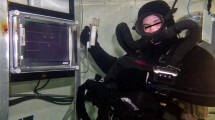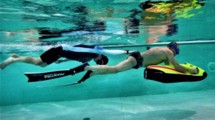Abstract
Decompression stress and exposure to hyperoxia may cause a reduction in transfer factor of the lung for carbon monoxide and in maximal aerobic capacity after deep saturation dives. In this study lung function and exercise capacity were assessed before and after a helium–oxygen saturation dive to a pressure of 2.5 MPa where the decompression rate was reduced compared with previous deep dives, and the hyperoxic exposure was reduced by administering oxygen intermittently at pressures of 50 and 30 kPa during decompression. Eight experienced divers of median age 41 years (range 29–48) participated in the dive. The incidence of venous gas microemboli was low compared with previous deep dives. Except for one subject having treatment for decompression sickness, no changes in lung function or angiotensin converting enzyme, a marker of pulmonary endothelial cell damage, were demonstrated. The modified diving procedures with respect to decompression rate and hyperoxic exposure may have contributed to the lack of changes in lung function in this dive compared with previous deep saturation dives.


Similar content being viewed by others
References
Brizio-Molteno L, Piano G, Warpeha RL, Solliday NH, Molteni A, Angelats J, Lewis N, Patejak-Radwanski H (1992) Angiotensin−1-converting enzyme activity as an index of pulmonary damage in thermal injury with or without smoke inhalation. Ann Clin Lab Sci 22:1–10
Carturan D, Boussuges A, Vanuxem P, Bar-Hen A, Burnet H, Gardette B (2002) Ascent rate, age, maximal oxygen uptake, adiposity and circulating venous bubbles after diving. J Appl Physiol 93:1349–1356
Cotes JE (1979) Allowance for the effect on transfer factor of variation in haemoglobin concentration and in capillary oxygen tension. In: Cotes JE (ed) Lung function, 4th edn. Blackwell Scientific Publications, London, pp 245–246
Cotes JE, Davey JS, Reed JW, Rooks M (1987) Respiratory effects of a single saturation dive to 300 m. Br J Ind Med 44:76–82
Cotes JE, Chinn DJ, Quanjer PhH, Roca J, Yernault J-C (1993) Standardization of the measurement of transfer factor (diffusion capacity). Eur Respir J 6(suppl 16):41–52
Eckenhoff RG, Vann RD (1985) Air and nitrox saturation decompression. A report of 4 schedules and 77 subjects. Undersea Biomed Res 12:41–52
Fracica PJ, Knapp MJ, Piantadosi CA, Takeda K, Fulkerson WJ, Coleman RE, Wolfe WG, Crapo DJ (1991) Responses of baboons to prolonged hyperoxia: physiology and qualitative pathology. J Appl Physiol 71:2352–2362
Grønning M, Hjelle J, Segadal K, Skeidsvoll H, Thorsen E, Troland K, Sundal E, Nyland H (2003) Neurological deficits during and after a simulated dive to 250 MSW. In: Jansen EC, Mortensen CR, Hyldegaard O (eds) Proceedings of 29th Annual meeting of European Underwater and Baromedical Society, Copenhagen, p 138
Hamilton RW, Thalmann ED (2003) Decompression practice. In: Brubakk AO, Neuman TS (eds) Bennett and Elliott’s physiology and medicine of diving. Saunders, Edinburgh, pp 455–500
Hendricks PL, Hall DA, Hunter WL Jr, Haley PJ (1977) Extension of pulmonary oxygen tolerance in man at 2 ATA by intermittent oxygen exposure. J Appl Physiol 42:593–599
Hofsø D, Ulvik RJ, Segadal K, Hope A, Thorsen E (2005) Changes in erythropoietin and haemoglobin concentrations in response to saturation diving. Eur J Appl Physiol 95:191–196
Johansen KB, Marstein S, Aas P (1987) Automated method for the determination of angiotensin converting enzyme in serum. Scand J Clin Lab Invest 47:411–414
Lehnigk B, Jorres RA, Elliott DH, Holthaus J, Magnussen H (1997) Effects of a single saturation dive on lung function and exercise performance. Int Arch Occup Environ Health 69:201–208
Marabotti C, Chiesa F, Scalzini A, Antonelli F, Lari R, Franchini C, Data PG (1999) Cardiac and humoral changes induced by recreational scuba diving. Undersea Hyperb Med 26:151–158
Nossum V, Koteng S, Brubakk AB (1999) Endothelial damage by bubbles in the pulmonary artery of the pig. Undersea Hyperb Med 26:1–8
Quanjer PhH, Tammeling GJ, Cotes JE, Pedersen OF, Peslin R, Yernault J-C (1993) Lung volumes and forced ventilatory flows. Eur Respir J 6(suppl 16):5–40
Segadal K, Risberg J, Eftedal O, Hope A, Thorsen E, Suzuki S, Stuhr L, Marstein S, Sundland H, Holand B, Hjelle J, Brubakk AO (2003) A simulated 250 MSW saturation dive: venous gas emboli, pulmonary function, maximum oxygen uptake and angiotensin converting enzyme. In: Jansen EC, Mortensen CR, Hyldegaard O (eds) Proceedings of 29th Annual meeting of European Underwater and Baromedical Society, Copenhagen, p 98
Spencer MP, Clark HF (1972) Precordial monitoring of pulmonary gas embolism and decompression sickness. Aerosp Med 43:762–767
Suzuki S, Ikeda T, Hashimoto A (1991) Decrease in the single breath diffusing capacity after saturation dives. Undersea Biomed Res 18:103–109
Tetzlaff K, Friege L, Reuter M (1998) Expiratory flow limitation in compressed air divers and oxygen divers. Eur Respir J 12:895–899
Thorsen E, Segadal K, Kambestad BK, Gulsvik A (1990a) Divers’ lung function: small airways disease? Br J Ind Med 47:519–523
Thorsen E, Hjelle J, Segadal K, Gulsvik A (1990b) Exercise tolerance and pulmonary gas exchange after deep saturation dives. J Appl Physiol 68:1809–1814
Thorsen E, Segadal K, Reed JW, Elliott C, Gulsvik A, Hjelle J (1993) Contribution of hyperoxia to reduced pulmonary function after deep saturation dives. J Appl Physiol 75:657–662
Thorsen E, Segadal K, Kambestad BK (1994) Mechanisms of reduced pulmonary function after a saturation dive. Eur Respir J 7:4–10
Acknowledgments
This work was supported by Stolt-Halliburton Joint Venture (SHJV), The Petroleum Safety Authority Norway (PSA), Esso Norge, Norsk Hydro ASA and Statoil ASA.
Author information
Authors and Affiliations
Corresponding author
Rights and permissions
About this article
Cite this article
Thorsen, E., Segadal, K., Stuhr, L.E.B. et al. No changes in lung function after a saturation dive to 2.5 MPa with intermittent reduction in \( P_{{{{\rm O}}_{{{\rm 2}}} }} \) during decompression. Eur J Appl Physiol 98, 270–275 (2006). https://doi.org/10.1007/s00421-006-0276-8
Accepted:
Published:
Issue Date:
DOI: https://doi.org/10.1007/s00421-006-0276-8




